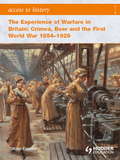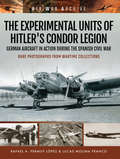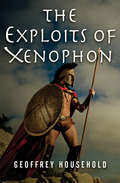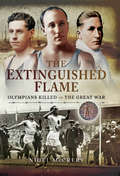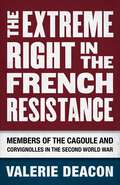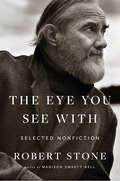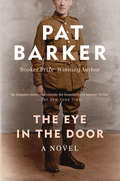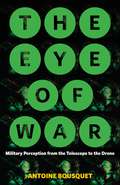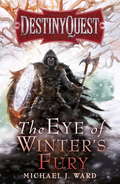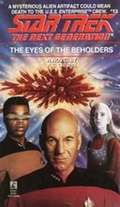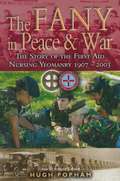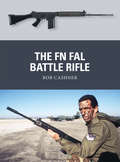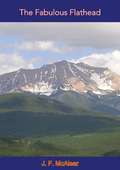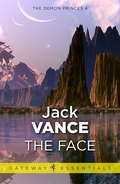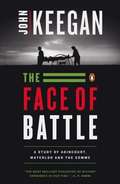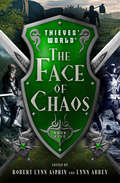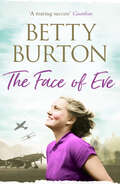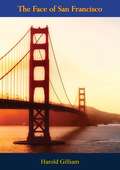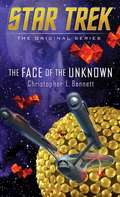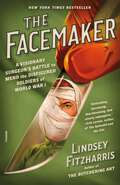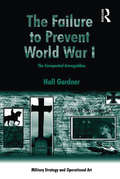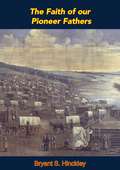- Table View
- List View
The Experience of Warfare in Britain: Crimea, Boer and the First World War 1854-1929 (Access to History)
by Alan FarmerAbout the series: The Access to History series is the most popular and trusted series for advanced level history students, offering: <P><P>Authoritative, engaging and accessible content <Br>Comprehensive coverage of the AS and A level history specifications<BR>Design features, study guides and web support to help students achieve exam success.<P>About the book: <P>This title covers the experience of warfare in Britain and the social and political effects that had in the late nineteenth and early twentieth centuries. It examines major questions such as:<P>What was the impact of the Crimean War?<BR>What was the impact of the Second Boer War?<BR>What was the experience of war on the Western Front?<BR>What was the impact of the First World War on the Home Front?<P>Throughout the book, key dates, terms and issues are highlighted, and historical interpretations of key debates are outlined. Summary diagrams are included to consolidate knowledge and understanding of the period, and exam-style questions and tips written by a senior examiner provide the opportunity to develop exam skills.
The Experimental Units of Hitler's Condor Legion: German Aircraft In Action During the Spanish Civil War (Air War Archive)
by Rafael A. Permuy LópezAt the start of the Spanish Civil War the nationalists sought help for their cause from Germany, following which volunteers from the German Air Force and Army formed what was called the Condor Legion. This force made a significant contribution to General Francos eventual victory and this included two experimental air units, known as VJ/88 and VB/88. The formers mission was to combat test the new monoplane fighters; the Messerschmitt Bf 109 and the Heinkel He 112. The latter groups task was to test the new twin-engine, retractable undercarriage bombers; the Heinkel He 111, the fast Dornier Do 17 and the Junkers Ju 86.The Heinkels made their combat debut on 9 March 1937, when they attacked Republican held airfields in support of the Battle of Guadalajara. The Heinkel proved superior to the two other German medium bombers, being both faster and carrying a heavier bomb load. Likewise, the Messerschmitt Bf 109 was quickly found to be the better of the two fighters. This book aims to examine the history of the men and machines that served in those units. The Fhrer thought the matter over. I urged him to give support [to Franco] under all circumstances, firstly, in order to prevent the further spread of communism in that theatre and, secondly, to test my young Luftwaffe at this opportunity in this or that technical respect.Herman Gring at the Nuremberg War Trials.
The Exploits of Xenophon
by Geoffrey HouseholdThousands of miles from home, one soldier leads an army to safety The war with Sparta is over, and Athens is at peace for the first time in thirty years. Their Greek enemies subdued, the generals of Athens turn their eyes to the East, where the Persian Empire stretches to the edge of the known world. Never before have Greek soldiers marched into Persia. Xenophon will be among the first. A warrior whose bravery is matched only by his intelligence, Xenophon is a natural leader. When his army of ten thousand men is stranded far from home, it is up to him to lead them back to Greece without sacrificing the principles of democracy that they hold so dear. A retelling of Xenophon's classic Anabasis, this is a thrilling tale of bravery and survival, in which the mind is as valuable a weapon as the sword.
The Extinguished Flame: Olympians Killed in The Great War
by Nigel McCreryIn August 2016 the world will be spellbound by the Olympic Games in Rio de Janeiro as 10,500 athletes from 206 countries compete in 306 events. Tracing their origins back to the Greeks in 776 BC, the history of the Olympics is a glorious one but it has had its darker moments.During the First World War no fewer than 135 Olympians perished. Many had won Gold, Silver and Bronze medals. They came not just from the UK, Germany, France, USA but from all over the globe.Wyndham Halswelle, killed in action on 31 March 1915, won a Gold, Silver and Bronze medals in both field and track events. The Frenchman Leon Flameng, the fastest cyclist ever, died on 2 January 1917, having won Gold, Silver and Bronze medals in the 1896 Olympics. The German Fritz Bartholomae, killed in action 12 September 1915, won a Bronze in the rowing eights during the 1912 Olympics. The list of these heroes goes on and on. Each Olympian, who made the supreme sacrifice, is honoured in this magnificent book by a summary of their life, sporting achievement and manner of their death.
The Extreme Right in the French Resistance: Members of the Cagoule and Corvignolles in the Second World War
by Valerie DeaconIn the aftermath of World War II, historical accounts and public commentaries enshrined the French Resistance as an apolitical, unified movement committed to upholding human rights, equality, and republican values during the dark period of German occupation. Valerie Deacon complicates that conventional view by uncovering extreme-right participants in the Resistance, specifically those who engaged in conspiratorial, anti-republican, and quasi-fascist activities in the 1930s, but later devoted themselves to freeing the country from Nazi control. The political campaigns of the 1930s—against communism, republicanism, freemasonry, and the government—taught France’s ultra-right-wing groups to organize underground movements. When France fell to the Germans in 1940, many activists unabashedly cited previous participation in groups of the extreme right as their motive for joining the Resistance. Deacon’s analysis of extreme-right participation in the Resistance supports the view that the domestic situation in Nazi-controlled France was more complex than had previously been suggested. Extending beyond past narratives, Deacon details how rightist resisters navigated between different options in the changing political context. In the process, she refutes the established view of the Resistance as apolitical, united, and Gaullist. The Extreme Right in the French Resistance highlights the complexities of the French Resistance, what it meant to be a resister, and how the experiences of the extreme right proved incompatible with the postwar resistance narrative.
The Eye You See With: Selected Nonfiction
by Robert StoneThe definitive collection of nonfiction—from war reporting to literary criticism to the sharpest political writing—from the &“legend of American letters&” (Vanity Fair) Robert Stone was a singular American writer, a visionary whose award-winning novels—including Dog Soldiers, Outerbridge Reach, and Damascus Gate—earned him comparisons to literary lions ranging from Samuel Beckett to Ernest Hemingway to Graham Greene. Stone had an almost prophetic grasp of the spirit of his age, which he captured with crystalline clarity in each of his novels. Of course, he was also a sharp and brilliant observer of American life, and his nonfiction writing is revelatory. The Eye You See With—the first and only collection of Robert Stone&’s nonfiction—was carefully selected by award-winning novelist and Stone biographer Madison Smartt Bell. Divided into three sections, the collection includes the best of Stone&’s war reporting, his writing on social change, and his reflections on the art of fiction. This is an extraordinary volume that offers up a clear-eyed look at the 20th century and secures Robert Stone&’s place as one of the most original figures in all of American letters.
The Eye in the Door: The Second Volume Of The Regeneration Trilogy (The Regeneration Trilogy #2)
by Pat BarkerIt is the spring of 1918, and Britain is faced with the possibility of defeat by Germany. A beleaguered government and a vengeful public target two groups as scapegoats: pacifists and homosexuals. Many are jailed, others lead dangerous double lives, the "the eye in the door" becomes a symbol of the paranoia that threatens to destroy the very fabric of British society. <p><p> Central to this novel are such compelling, richly imagined characters as the brilliant and compassionate Dr. William Rivers; his most famous patient, the poet Siegfried Sassoon; and Lieutenant Billy Prior, who plays a central role as a domestic intelligence agent. With compelling, realistic dialogue and a keen eye for the social issues that have gone overlooked in mainstream media, The Eye in the Door is a triumph that equals Regeneration and the third novel in the trilogy, the 1995 Booker Prize-winning The Ghost Road, establishing Pat Barker's place in the very forefront of contemporary novelists.
The Eye of War: Military Perception from the Telescope to the Drone
by Antoine BousquetHow perceptual technologies have shaped the history of war from the Renaissance to the present From ubiquitous surveillance to drone strikes that put &“warheads onto foreheads,&” we live in a world of globalized, individualized targeting. The perils are great. In The Eye of War, Antoine Bousquet provides both a sweeping historical overview of military perception technologies and a disquieting lens on a world that is, increasingly, one in which anything or anyone that can be perceived can be destroyed—in which to see is to destroy. Arguing that modern-day global targeting is dissolving the conventionally bounded spaces of armed conflict, Bousquet shows that over several centuries, a logistical order of militarized perception has come into ascendancy, bringing perception and annihilation into ever-closer alignment. The efforts deployed to evade this deadly visibility have correspondingly intensified, yielding practices of radical concealment that presage a wholesale disappearance of the customary space of the battlefield. Beginning with the Renaissance&’s fateful discovery of linear perspective, The Eye of War discloses the entanglement of the sciences and techniques of perception, representation, and localization in the modern era amid the perpetual quest for military superiority. In a survey that ranges from the telescope, aerial photograph, and gridded map to radar, digital imaging, and the geographic information system, Bousquet shows how successive technological systems have profoundly shaped the history of warfare and the experience of soldiering. A work of grand historical sweep and remarkable analytical power, The Eye of War explores the implications of militarized perception for the character of war in the twenty-first century and the place of human subjects within its increasingly technical armature.
The Eye of Winter's Fury: Destiny Quest Book 3 (DESTINYQUEST)
by Michael J. WardThe cold north awaits you ... War is coming to Valeron. From the west, the blood-thirsty Wiccans burn and pillage their way towards the capital - where an ill and ineffectual king is beset on all sides by the scheming of ambitious men. His youngest son, Prince Arran, untested in combat and naïve to ways of the world, is sent on a fool's errand - to convince a cowardly lord to honour his oath and defend the realm from its enemies. But the real threat is yet to be revealed ...You are Prince Arran, son of Leonidas and second heir to the throne of Valeron. They call you the ghost prince - the sickly boy who haunts the palace library, filling your head with dreams of high adventure. Now, as the shadows lengthen and danger threatens your beleaguered kingdom, you must finally prove yourself. It is time to take up your hallowed sword, Duran's Heart, and forge your own destiny in a cruel and savage world - one that has no mercy for weakling princes. No happy endings. Will you defy fate and become a great hero of legend? You decide in this epic fantasy adventure - one where you make the decisions. The cold north awaits you ... are you ready for the challenge?
The Eyes of the Beholders: The Eyes of the Beholders (Star Trek: The Next Generation #13)
by A.C. CrispinThe U.S.S. Enterprise is sent on a mission to find missing Klingon ships, but what they find threatens the lives of all those aboard the ship. After several Federation and Klingon ships disappear while traveling a newly opened trade route, the U.S.S. Enterprise is sent to investigate. Their quest leads Captain Picard and his crew to an eerie space graveyard full of ships of every size and description, all of them, dead in space. At the center of the graveyard lies a huge, incredibly powerful artifact, constructed by an ancient alien race. And as the crew struggles to solve the mystery of the artifact, they unwittingly trigger its awesome power, a power that threatens insanity and death to all aboard the Starship Enterprise.
The FANY in Peace & War: The Story of the First Aid Nursing Yeomanry 1907–2003
by Hugh PophamThe strangely named First Aid Nursing Yeomanry traces its origins to the Great War. As a mark of their outstanding service they remained in being between the wars. However, it is for their service during the Second World War that they are best known. They worked in a wide variety of roles both at home and overseas, both overt and covert and today are still making a vital contribution.
The FN FAL Battle Rifle
by Steve Noon Robert CashnerOf all the infantry small arms developed during World War II, one that generated the most interest was the German 'assault rifle', the StG 44 Sturmgewehr. This innovative weapon fired an intermediate cartridge much more powerful and long-ranged than the standard pistol rounds used in submachine guns, but smaller and lighter than a full-size 7.92mm rifle round, producing less recoil and enabling the soldier to carry more ammunition. The StG 44 and the Soviet weapon it inspired, the AK-47 in 7.62x39mm calibre, could still effectively and accurately engage targets on semi-automatic out to 300m, but when close-range firepower was needed could fire on full-automatic like a submachine gun.In the West, the NATO countries looked hard at new weapons to upgrade their own infantry arsenals and counter the AK-47. Although British and other designers developed their own prototype assault rifles chambered for intermediate cartridges, the Americans adopted the M14 'battle rifle' and forced a common full-length calibre, 7.62x51mm, on their NATO allies. Fabrique Nationale of Belgium designed a new military rifle, the Fusil Automatique Léger or FAL, as an assault rifle using a true intermediate cartirdge, but this innovative weapon also proved to be a successful battle rifle when adapted for the full-length NATO round. It was soon adopted by the military and police forces of no fewer than 93 nations around the globe, from the United Kingdom to Israel, and was manufactured under licence on every populated continent. It remains in production to this day and is regarded by most as the quintessential postwar battle rifle. In fact, the FAL dominated the militaries of the West to such a degree that its nickname became the Right Arm of the Free World. Roughly comparable in terms of size and weight to other contemporary battle rifles such as the American M14 and the German Heckler & Koch G3, the FAL proved to be reliable and well loved by its users. It performed reliably in a wide variety of small wars and insurgencies, in the hands of professional soldiers as well as those of hastily trained conscripts and essentially untrained guerrillas. It proved itself in harsh environments as varied as the cold, wet, featureless Falkland Islands in the South Atlantic, the snow and ice of Norway and northern Canada, the deep jungles of Vietnam and Malaya, the deserts of the Middle East, and the streets of Belfast. While thankfully never called upon for its original intent - facing down hordes of mechanized Soviet infantry on the plains of Western Europe - the FAL fulfilled every role it was asked to perform and remains a viable and well-respected weapon to this day.
The Fabulous Flathead
by J. F. McAlear Sharon BergmanThe Fabulous Flathead by Jesse Fay McAlear, as told to Sharon Bergman, is an extensive local history of the Flathead Indian Reservation, which is located in western Montana on the Flathead River. It is home to the Bitterroot Salish, Kootenai, and Pend d’Oreilles tribes—also known as the Confederated Salish and Kootenai Tribes of the Flathead Nation. The reservation was created through the July 16, 1855, Treaty of Hellgate.In addition to detailing the story of Montana’s Native Americans, who have lived there for more than 14,000 years, The Fabulous Flathead summarizes the anthropological information on the Confederated Tribes; treats the history of the tribes before the opening of the reservation; discusses cattle and buffalo on the reservation; and sketches transportation, economic development, the irrigation system, as well as other topics in Flathead history.
The Face (Gateway Essentials #204)
by Jack VanceBook four in the series which relate the story of Kirth Gersen as he exacts his revenge on five notorious criminals, collectively known as the Demon Princes, who carried his village off into slavery during his childhood.
The Face of Battle
by John KeeganMilitary historian John Keegan's groundbreaking analysis of combat and warfareThe Face of Battle is military history from the battlefield: a look at the direct experience of individuals at the "point of maximum danger." Without the myth-making elements of rhetoric and xenophobia, and breaking away from the stylized format of battle descriptions, John Keegan has written what is probably the definitive model for military historians. And in his scrupulous reassessment of three battles representative of three different time periods, he manages to convey what the experience of combat meant for the participants, whether they were facing the arrow cloud at the battle of Agincourt, the musket balls at Waterloo, or the steel rain of the Somme."The best military historian of our generation." -Tom Clancy
The Face of Battle: A Study of Agincourt, Waterloo, and the Somme
by John KeeganMilitary historian John Keegan's groundbreaking analysis of combat and warfare The Face of Battle is military history from the battlefield: a look at the direct experience of individuals at the "point of maximum danger. " Without the myth-making elements of rhetoric and xenophobia, and breaking away from the stylized format of battle descriptions, John Keegan has written what is probably the definitive model for military historians. And in his scrupulous reassessment of three battles representative of three different time periods, he manages to convey what the experience of combat meant for the participants, whether they were facing the arrow cloud at the battle of Agincourt, the musket balls at Waterloo, or the steel rain of the Somme. "The best military historian of our generation. " -Tom Clancy .
The Face of Battle: A Study of Agincourt, Waterloo, and the Somme
by John KeeganMilitary historian John Keegan's groundbreaking analysis of combat and warfareThe Face of Battle is military history from the battlefield: a look at the direct experience of individuals at the "point of maximum danger." Without the myth-making elements of rhetoric and xenophobia, and breaking away from the stylized format of battle descriptions, John Keegan has written what is probably the definitive model for military historians. And in his scrupulous reassessment of three battles representative of three different time periods, he manages to convey what the experience of combat meant for the participants, whether they were facing the arrow cloud at the battle of Agincourt, the musket balls at Waterloo, or the steel rain of the Somme."The best military historian of our generation." -Tom Clancy
The Face of Chaos: Storm Season, The Face Of Chaos, And Wings Of Omen (Thieves' World® #5)
by John Brunner Joe Haldeman Philip José FarmerWar looms over Sanctuary in the fifth Thieves&’ World® anthology compiled by the New York Times–bestselling author of the Phule&’s Company series. The invasion by the Beysibs, an amphibious humanoid race, brings unusual prosperity to the city of Sanctuary. But underneath the glittering façade lies a ticking time bomb, for the nefarious residents of Sanctuary don&’t take kindly to an invasion—well-meaning or otherwise . . . Join Janet Morris, C. J. Cherryh, Robert Lynn Asprin, Lynn Abbey, David Drake, and Diana L. Paxson as their stories unravel the fates of Sanctuary&’s favorite liars, thieves, assassins, and warriors. &“Abbey . . . understands Sanctuary and its characters. She also knows how to write a short story with a strong main character, a riveting plot that contains twists and turns, and a satisfying resolution. Best story in the book . . . Lalo is the most interesting of all of the characters in Thieves&’ World and his stories are always interesting. Paxson . . . spins an interesting and well written yarn that closes the book nicely.&” —brianbookreviews.blogspot.com
The Face of Eve (The Lu Wilmott Sagas)
by Betty BurtonFrom a British novelist acclaimed for her strong heroines and &“good writing&” filled with &“human insight,&” a woman spies for the Allied forces during WWII (The Irish Press). One woman&’s passionate courage during World War II When Eve left her hometown of Portsmouth, she&’d never intended to return. But now she has a confidence and maturity far beyond her years. This makes her a very attractive prospect to David Hatton, charged with selecting highly unusual, independent, and intelligent candidates for the Special Operations Executive. For in the war that lies ahead, brute force won&’t be enough. Eve becomes part of the Second World War in a way that few others could manage. And when the time for role-playing and secrecy is over, who can say which is the real face of Eve? The extraordinary conclusion to Betty Burton&’s captivating Lu Wilmott novels. &“It is encouraging when someone like Betty Burton manages against the odds to become a roaring success.&” —The Guardian
The Face of San Francisco
by Harold GilliamThis is a love poem in prose—a shining ode to the most beautiful, sophisticated, decadent, provincial, elusive, and utterly paradoxical city in America. It is also a romantic portrait—a masterwork that captures the incredible loveliness of the city’s face even as it reveals a dark secret or two of its inconstant heart.This is THE FACE OF SAN FRANCISCO, from the Bay Bridge to the back alleys, from the dazzling mansions of Pacific Heights to the down-at-the-heels pads of North Beach—captured in words by the author of San Francisco Bay, and columnist for the San Francisco Examiner, Harold Gilliam, and caught in nearly 200 revealing faces by the camera of Phil Palmer (1911-1992).
The Face of the Unknown (Star Trek: The Original Series)
by Christopher L. BennettContinuing the milestone 50th anniversary celebration of Star Trek—a brand-new novel of The Original Series featuring James T. Kirk, Spock, and the crew of the USS Enterprise!Investigating a series of violent raids by a mysterious predatory species, Captain James T. Kirk discovers that these events share a startling connection with the First Federation, a friendly but secretive civilization contacted early in the USS Enterprise’s five-year mission. Traveling to the First Federation in search of answers, the Enterprise suddenly comes under attack from these strange marauders. Seeking refuge, the starship finds its way to the true home of the First Federation, an astonishing collection of worlds hidden from the galaxy beyond. The inhabitants of this isolated realm are wary of outsiders, and some accuse Kirk and his crew for bringing the wrath of their ancient enemy down upon them. When an attempt to stave off disaster goes tragically wrong, Kirk is held fully accountable, and Commander Spock learns there are even deeper forces that threaten this civilization. If Kirk and Spock cannot convince the First Federation's leaders to overcome their fears, the resulting catastrophe could doom them all!
The Facemaker: A Visionary Surgeon's Battle to Mend the Disfigured Soldiers of World War I
by Lindsey FitzharrisA New York Times Bestseller"Enthralling. Harrowing. Heartbreaking. And utterly redemptive. Lindsey Fitzharris hit this one out of the park." —Erik Larson, author of The Splendid and the VileLindsey Fitzharris, the award-winning author of The Butchering Art, presents the compelling, true story of a visionary surgeon who rebuilt the faces of the First World War’s injured heroes, and in the process ushered in the modern era of plastic surgery.From the moment the first machine gun rang out over the Western Front, one thing was clear: humankind’s military technology had wildly surpassed its medical capabilities. Bodies were battered, gouged, hacked, and gassed. The First World War claimed millions of lives and left millions more wounded and disfigured. In the midst of this brutality, however, there were also those who strove to alleviate suffering. The Facemaker tells the extraordinary story of such an individual: the pioneering plastic surgeon Harold Gillies, who dedicated himself to reconstructing the burned and broken faces of the injured soldiers under his care.Gillies, a Cambridge-educated New Zealander, became interested in the nascent field of plastic surgery after encountering the human wreckage on the front. Returning to Britain, he established one of the world’s first hospitals dedicated entirely to facial reconstruction. There, Gillies assembled a unique group of practitioners whose task was to rebuild what had been torn apart, to re-create what had been destroyed. At a time when losing a limb made a soldier a hero, but losing a face made him a monster to a society largely intolerant of disfigurement, Gillies restored not just the faces of the wounded but also their spirits.The Facemaker places Gillies’s ingenious surgical innovations alongside the dramatic stories of soldiers whose lives were wrecked and repaired. The result is a vivid account of how medicine can be an art, and of what courage and imagination can accomplish in the presence of relentless horror.
The Factory Girl
by Maggie FordFrom rags to riches...With the Armistice only a few months passed, times are hard for eighteen-year-old Geraldine Glover. A machinist at Rubins clothing factory in the East End, she dreams of a more glamorous life. When she meets Tony Hanford, the young and handsome proprietor of a small jeweller's shop in Bond Street, Geraldine is propelled into a new world – but it comes at a heavy price...
The Failure to Prevent World War I: The Unexpected Armageddon (Military Strategy and Operational Art)
by Hall GardnerWorld War I represents one of the most studied, yet least understood, systemic conflicts in modern history. At the time, it was a major power war that was largely unexpected. This book refines and expands points made in the author’s earlier work on the failure to prevent World War I. It provides an alternative viewpoint to the thesis of Christopher Clark, Fritz Fischer, Paul Kennedy, among others, as to the war's long-term origins. By starting its analysis with the causes and consequences of the 1870-71 Franco-Prussian War and the German annexation of Alsace-Lorraine, the study systematically explores the key geostrategic, political-economic and socio-cultural-ideological disputes between France, Germany, Austria-Hungary, Italy, Russia, Japan, the United States and Great Britain, the nature of their foreign policy goals, alliance formations, arms rivalries, as well as the dynamics of the diplomatic process, so as to better explain the deeper roots of the 'Great War'. The book concludes with a discussion of the war's relevance and the diplomatic failure to forge a possible Anglo-German-French alliance, while pointing out how it took a second world war to realize Victor Hugo’s nineteenth-century vision of a United States of Europe-a vision now being challenged by financial crisis and Russia's annexation of Crimea.
The Faith of our Pioneer Fathers
by Bryant S. HinckleyMinstrels, troubadours—the story tellers of old—stirred the hearts of men and moved them to action as they retold the sagas of valor and devotion of ancient heroes.Gathered here are stirring stories, sagas of faith and devotion, associated with the careers of twenty-two heroic figures of our day.From careers like these we gain encouragement and strength which drive away fear and doubt. Frustrations and defeats become the challenges which beckon us to try again in the spirit which is sustained and made ready to enjoy ultimate victory.From these we learn fortitude in the face of adversity and gratitude to Divine Providence for the generous rewards of faithfulness.Though several of the stories included in “Faith of Our Pioneer Fathers” are familiar in other settings, some are available for the first time.
